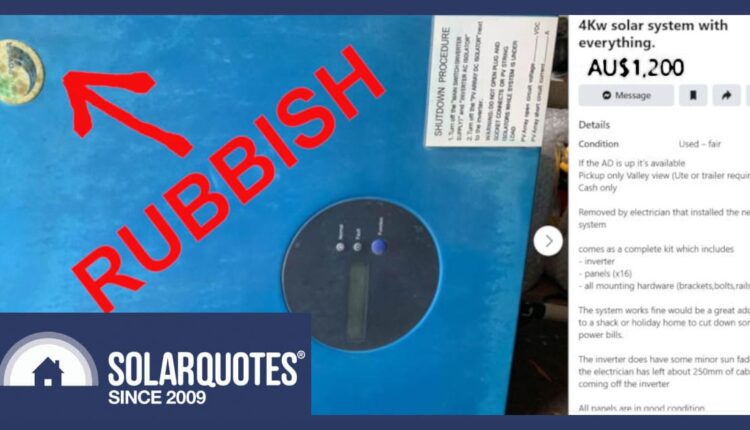Used Solar Energy – Don’t waste everyone’s time
This would NOT be a good addition to your cabin; In fact, Samil inverters were not good when new.
As solar power systems age and electricity prices rise, the used solar power system market is experiencing an upswing in used solar power systems. But please don’t think that you can screw these bargains onto your roof and easily save a few bucks.
Unfortunately, used solar energy is almost worthless
The skeptics will say I’m just trying to drum up business for the solar industry, and it certainly seems like a terribly wasteful statement, but…
- higher energy bills,
- higher electrical standards,
- updated rules,
- and falling hardware prices
…means the systems I installed for $5/watt are now retailing for a tenth of that, while anything used automatically goes back to half that value.
Labor in Australia is expensive
Labor is expensive in Australia. So if someone is scrambling around on the roof, they might as well install new equipment with a new warranty.
As I explained, even reinstalling the solar panels you already own can be marginal.
I have seen a solar explosion for the last 16 years. It’s amazing to see the cost of new systems fall from their skyrocketing heights to the point where you can install about 6kW of a cheap grid-connected system (poor) for little more than $3,000.
My first system was half the size and cost four times as much just for the panels and inverter.
Not everything is worthless
If you have a power system that’s crying out for an additional row of modules, or you can find some that fit your existing array, you might consider adding a few modules.
Assuming you have enough space and electrical headroom, many inverters installed with 6.6kW panels can handle a few more to get from 133% to 150%. However, note that this is technically against the rules and you may be forced to return your original STC incentive payment.
However, 133% is a silly Australian guideline that was somehow made a rule, and as far as rules go, the Clean Energy Regulator doesn’t inspect systems that are more than two years old.
Half-cut or split cell panels have only become common in recent years. They have clear advantages. Assuming it’s a reputable brand, I would consider using it.
Off grid is different
People who choose to live in the bushes find that they can build a very useful solar array using old solar panels to charge batteries. Provided you use panels manufactured after 2013 with appropriate fire ratings and keep the system voltage below 50 volts DC, it’s technically legal to do this yourself.
However, keep in mind that a decent system to run a modern home does not require 12V or 24V rated equipment.
It is more common, more powerful and more cost-effective to use the standard 48V. The catch is that a 48V battery may require 58V during its charging cycle, meaning setup and wiring are licensed work. Not to mention the AS4509 rules for battery installations.
Thanks to the persistence of some active panel buyers, thousands of old Australian solar panels are finally ending up overseas.
Send old panels abroad
Thousands of Australian solar panels have been shipped and resold to developing countries to charge small batteries and power solar pumps. It is a good primary reuse of expensive technology and resources.
Some in the industry compare used panel buyers to seagulls. Perhaps it’s unkind, but many are practical helpers who are a useful part of the new solar industry.
While experimental programs are underway in Australia to learn about and establish a proper recycling protocol, it is already known that the amount of work involved in testing old modules and labeling them as electrically safe is already well known.
In addition, packaging, handling and freight costs quickly bring the value of used solar modules up to the level of new modules coming from the factory in China at 8 cents/watt.
Used solar energy cannot have a new connection
Any newly connected system must comply with the latest rules or it will not receive network approval.
This includes not only grid stability settings, but increasingly also internet-enabled inverters with remote control, also known as flexible exports and emergency backstop requirements.
Some inverters are now retrocompatible. At this point we have to give great praise to Fronius, because for 10 years the market-leading Snap inverters will meet all new requirements with a firmware update1.
So the system pictured below probably isn’t a bad value if you hire a tame electrician to install it.
It’s not for nothing that Fronius’ snap inverters are so popular.
Take-home message: Do not take a used solar system home with you
Most solar installation work must be completed by an electrician. As a licensed contractor and qualified roofer, I performed the mechanical portions of the installation and assisted the qualified electrical tradesmen I employed. However, the requirements are now stricter.
They require a connection permit, network portal logins, certificates of compliance and special tools, so even non-solar Sparkies are often handed over to those who know the work best and have the appropriate training.
Don’t try to DIY
If you throw old junk on the roof and ring for a Sparky to make final contact, you won’t get any joy.
Those in the increasingly competitive solar industry are simply not interested in the reputational or licensing risk that comes with releasing a system that someone else has installed – especially if the equipment is outdated and non-compliant.
Footnotes
- except the Fronius Galvo series; They cannot be made compliant ↩



Comments are closed.